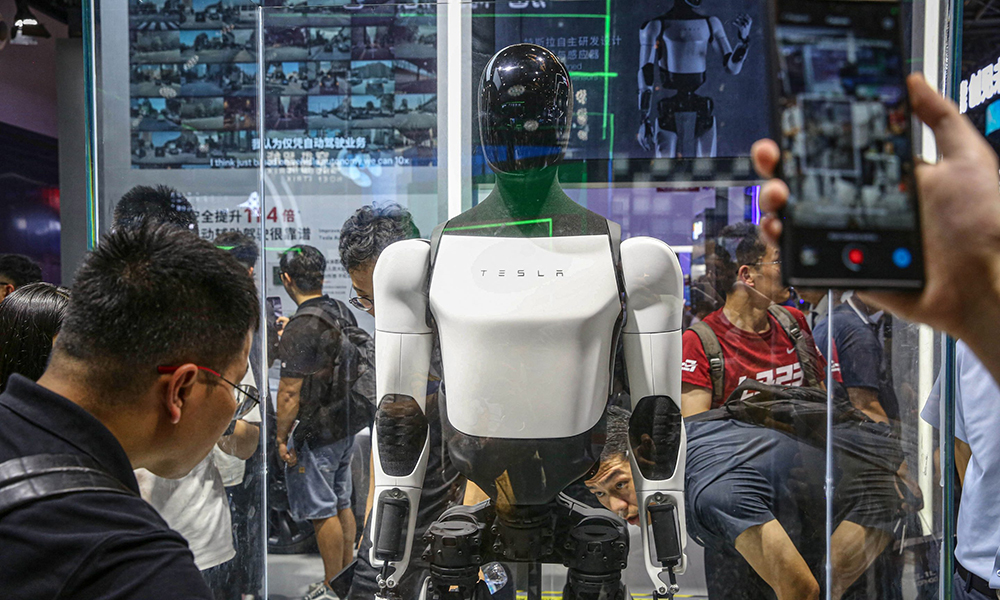
特斯拉正在采取下一步舉措開發(fā)人形機器人擎天柱——或者說,至少它正在雇傭員工來執(zhí)行上述步驟,。時薪最高可達48美元,,你可以幫助收集數(shù)據(jù),訓練特斯拉的人工智能機器人,,使公司工廠的工作實現(xiàn)自動化,。
根據(jù)領(lǐng)英(LinkedIn)、Indeed和特斯拉網(wǎng)站上的招聘信息,,埃隆·馬斯克(Elon Musk)旗下的電動汽車公司正在招聘“數(shù)據(jù)收集操作員”來收集運動信息,,并為擎天柱機器人提供設(shè)備反饋。工作人員需要穿上動作捕捉服,,戴上虛擬現(xiàn)實頭戴式顯示器來模擬機器人的動作和行動,。根據(jù)招聘要求,應聘者必須每天行走7小時以上,,身高在5英尺7英寸(約合1.7米)到5英尺11英寸(約合1.8米)之間,,以便操作動作捕捉服。報酬在每小時25.25美元到48美元之間,。
在今年5月特斯拉社交媒體上分享的一段視頻中,,數(shù)十名遠程操作人員戴著動作捕捉和虛擬現(xiàn)實設(shè)備,站在擎天柱機器人旁邊,。在一個寬敞的白色房間里,,員工們站在一塊黑色的墊子上,緩慢而機械地模仿抬起和放置物品的動作,,而擎天柱機器人也在完成同樣的動作,,只不過它們面前擺放的是真實的物品。在同一個空間里,,機器人在沒有人類員工陪同的情況下練習行走和完成其他任務,,比如疊衣服。
特斯拉于2021年宣布了擎天柱項目,,目標是用它來完成工廠中“不安全,、重復或枯燥”的任務。在疫情時期勞動力短缺的刺激下,,這一舉措與全行業(yè)加大了對自動化的投資相一致,。據(jù)Westernacher Consulting的數(shù)據(jù),截至2016年,,10%的倉庫報告使用了意義重大的自動化技術(shù),,而根據(jù)麥肯錫(McKinsey)的數(shù)據(jù),到2030年,機器人出貨量預計將以每年至高50%的速度增長,。
但特斯拉的自動化努力尚未取得成果。與馬斯克的其他雄心一樣,,擎天柱的時間表也是承諾過多,,卻未能兌現(xiàn)。2022年,,馬斯克表示,,擎天柱最早可能在2023年開始生產(chǎn)。機器人專家最初對擎天柱感到失望,,他們在看過2022年的Bumble C機器原型后,,發(fā)現(xiàn)它在很大程度上不盡如人意。
美國電氣與電子工程師協(xié)會會刊《IEEE Spectrum》的機器人編輯埃文·阿克曼(Evan Ackerman)在為該雜志撰寫的文章中寫道:“雖然馬斯克在臺上短暫展示的人形機器人沒有任何問題,,但也沒有任何獨特之處,。我們對特斯拉抱有更高的期望(即使不一定會實現(xiàn))?!?/p>
從那時起,,擎天柱項目取得了長足的進步。根據(jù)特斯拉2024年第二季度財報,,該機器人最近的一次迭代首次在特斯拉的一家工廠完成了處理電池的自主任務,。馬斯克在7月份表示,這些機器人最早將于明年投入生產(chǎn),,供內(nèi)部使用,,目標是在2026年出售給其他公司。特斯拉沒有回應《財富》雜志的置評請求,。
對“擎天柱”的樂觀態(tài)度
這位特斯拉首席執(zhí)行官一直看好擎天柱對特斯拉運營的影響,,相信這款機器人可以推動這家電動汽車公司的估值達到25萬億美元。這是其目前估值6929.4億美元的36倍多,,是蘋果公司(Apple)3.41萬億美元市值的7倍多,。馬斯克預計最終產(chǎn)量將超過200億,他認為,,隨著工業(yè)需求的不斷增長,,全球80億人將需要這款產(chǎn)品。
但任務自動化機器人的競爭正在升溫,。今年2月,,另一家人工智能機器人公司Figure宣布在最新一輪融資中獲得6.75億美元,估值達到26億美元,。今年年初,,該公司在OpenAI的創(chuàng)業(yè)基金、微軟(Microsoft),、英偉達(Nvidia)和杰夫·貝索斯(Jeff Bezos)的Bezos Expeditions的支持下,,與寶馬(BMW)達成了一項商業(yè)協(xié)議,,協(xié)助這家汽車制造商進行汽車制造。在確定了這項技術(shù)的最佳用途后,,F(xiàn)igure和寶馬將在該公司位于南卡羅來納州斯帕坦堡的工廠使用這些機器人,。
如果特斯拉想要與競爭對手一決高下,它還得費一番功夫,。佐治亞理工學院(Georgia Institute of Technology)機器人教授,、英偉達研究院(Nvidia Research)高級研究員阿尼米什·加格(Animesh Garg)表示,擎天柱機器人將需要不斷更新和制作新原型,。機器人的每一個組件和升級都是量身定制的,,而員工為收集機器人運行數(shù)據(jù)所進行的早期研究是一項巨大的投資,還會帶來風險,。
加格告訴科技網(wǎng)站“商業(yè)內(nèi)幕”(Business Insider):“大規(guī)模生產(chǎn)機器人是極其困難的,。你需要的數(shù)據(jù)收集量動輒就會耗費5億美元,而真正的問題是‘即使你做到了,,你能取得成功嗎?’難題在于無法保證成功,。”(財富中文網(wǎng))
譯者:中慧言-王芳
特斯拉正在采取下一步舉措開發(fā)人形機器人擎天柱——或者說,,至少它正在雇傭員工來執(zhí)行上述步驟,。時薪最高可達48美元,你可以幫助收集數(shù)據(jù),,訓練特斯拉的人工智能機器人,,使公司工廠的工作實現(xiàn)自動化。
根據(jù)領(lǐng)英(LinkedIn),、Indeed和特斯拉網(wǎng)站上的招聘信息,,埃隆·馬斯克(Elon Musk)旗下的電動汽車公司正在招聘“數(shù)據(jù)收集操作員”來收集運動信息,并為擎天柱機器人提供設(shè)備反饋,。工作人員需要穿上動作捕捉服,,戴上虛擬現(xiàn)實頭戴式顯示器來模擬機器人的動作和行動。根據(jù)招聘要求,,應聘者必須每天行走7小時以上,,身高在5英尺7英寸(約合1.7米)到5英尺11英寸(約合1.8米)之間,以便操作動作捕捉服,。報酬在每小時25.25美元到48美元之間,。
在今年5月特斯拉社交媒體上分享的一段視頻中,數(shù)十名遠程操作人員戴著動作捕捉和虛擬現(xiàn)實設(shè)備,,站在擎天柱機器人旁邊,。在一個寬敞的白色房間里,員工們站在一塊黑色的墊子上,緩慢而機械地模仿抬起和放置物品的動作,,而擎天柱機器人也在完成同樣的動作,,只不過它們面前擺放的是真實的物品。在同一個空間里,,機器人在沒有人類員工陪同的情況下練習行走和完成其他任務,,比如疊衣服,。
特斯拉于2021年宣布了擎天柱項目,目標是用它來完成工廠中“不安全,、重復或枯燥”的任務,。在疫情時期勞動力短缺的刺激下,這一舉措與全行業(yè)加大了對自動化的投資相一致,。據(jù)Westernacher Consulting的數(shù)據(jù),,截至2016年,10%的倉庫報告使用了意義重大的自動化技術(shù),,而根據(jù)麥肯錫(McKinsey)的數(shù)據(jù),,到2030年,機器人出貨量預計將以每年至高50%的速度增長,。
但特斯拉的自動化努力尚未取得成果,。與馬斯克的其他雄心一樣,擎天柱的時間表也是承諾過多,,卻未能兌現(xiàn),。2022年,馬斯克表示,,擎天柱最早可能在2023年開始生產(chǎn),。機器人專家最初對擎天柱感到失望,他們在看過2022年的Bumble C機器原型后,,發(fā)現(xiàn)它在很大程度上不盡如人意,。
美國電氣與電子工程師協(xié)會會刊《IEEE Spectrum》的機器人編輯埃文·阿克曼(Evan Ackerman)在為該雜志撰寫的文章中寫道:“雖然馬斯克在臺上短暫展示的人形機器人沒有任何問題,但也沒有任何獨特之處,。我們對特斯拉抱有更高的期望(即使不一定會實現(xiàn)),。”
從那時起,,擎天柱項目取得了長足的進步,。根據(jù)特斯拉2024年第二季度財報,該機器人最近的一次迭代首次在特斯拉的一家工廠完成了處理電池的自主任務,。馬斯克在7月份表示,,這些機器人最早將于明年投入生產(chǎn),供內(nèi)部使用,目標是在2026年出售給其他公司,。特斯拉沒有回應《財富》雜志的置評請求,。
對“擎天柱”的樂觀態(tài)度
這位特斯拉首席執(zhí)行官一直看好擎天柱對特斯拉運營的影響,相信這款機器人可以推動這家電動汽車公司的估值達到25萬億美元,。這是其目前估值6929.4億美元的36倍多,,是蘋果公司(Apple)3.41萬億美元市值的7倍多。馬斯克預計最終產(chǎn)量將超過200億,,他認為,,隨著工業(yè)需求的不斷增長,全球80億人將需要這款產(chǎn)品,。
但任務自動化機器人的競爭正在升溫,。今年2月,另一家人工智能機器人公司Figure宣布在最新一輪融資中獲得6.75億美元,,估值達到26億美元,。今年年初,該公司在OpenAI的創(chuàng)業(yè)基金,、微軟(Microsoft),、英偉達(Nvidia)和杰夫·貝索斯(Jeff Bezos)的Bezos Expeditions的支持下,與寶馬(BMW)達成了一項商業(yè)協(xié)議,,協(xié)助這家汽車制造商進行汽車制造,。在確定了這項技術(shù)的最佳用途后,F(xiàn)igure和寶馬將在該公司位于南卡羅來納州斯帕坦堡的工廠使用這些機器人,。
如果特斯拉想要與競爭對手一決高下,,它還得費一番功夫。佐治亞理工學院(Georgia Institute of Technology)機器人教授,、英偉達研究院(Nvidia Research)高級研究員阿尼米什·加格(Animesh Garg)表示,,擎天柱機器人將需要不斷更新和制作新原型。機器人的每一個組件和升級都是量身定制的,,而員工為收集機器人運行數(shù)據(jù)所進行的早期研究是一項巨大的投資,,還會帶來風險。
加格告訴科技網(wǎng)站“商業(yè)內(nèi)幕”(Business Insider):“大規(guī)模生產(chǎn)機器人是極其困難的,。你需要的數(shù)據(jù)收集量動輒就會耗費5億美元,,而真正的問題是‘即使你做到了,你能取得成功嗎?’難題在于無法保證成功,?!保ㄘ敻恢形木W(wǎng))
譯者:中慧言-王芳
Tesla is taking the next steps in developing its humanoid Optimus robots—or at least it’s hiring workers to take those literal steps. For up to $48 an hour, you could help collect data to train Tesla’s AI-powered robots, designed to automate work in company factories.
According to job listings on LinkedIn, Indeed, and Tesla’s website, Elon Musk’s electric vehicle company is hiring “data collection operators” to gather movement information and provide equipment feedback on the Optimus robots. Workers are required to wear motion-capture suits and virtual reality headsets to simulate the movements and actions of the bots. Per the job listing, applicants must be able to walk for over seven hours a day and should be between 5’7″ and 5’11″ in order to operate the motion-capture suits. Payment ranges between $25.25 and $48 per hour.
In a video shared across Tesla’s social media in May, dozens of teleoperations workers wear motion-capture and VR equipment and stand alongside the Optimus bots. Standing on a black mat in a large white room, workers mimic lifting and placing items slowly and mechanically, while Optimus bots complete that same motion, but with real items in front of them. In the same space, the robots practice walking and completing other tasks like folding laundry, unaccompanied by human workers.
Tesla announced its Optimus project in 2021, with the goal of using it to complete factory tasks that were “unsafe, repetitive or boring.” The initiative aligns with greater industry-wide investment in automation, spurred by pandemic-era labor shortages. As of 2016, 10% of warehouses reported using meaningful automation technology, according to Westernacher Consulting, with robot shipments expected to increase by up to 50% each year until 2030, per McKinsey data.
But Tesla’s automation efforts have not yet come to fruition. Like Musk’s other ambitions, Optimus’s timeline has overpromised and under-delivered. In 2022, Musk suggested Optimus production could begin as early as 2023. Optimus was initially met with disappointment from roboticists, who, after seeing the 2022 Bumble C prototype of the machine, found it largely underwhelming.
“While there’s absolutely nothing wrong with the humanoid robot that Musk very briefly demonstrated on stage, there’s nothing uniquely right, either,” Evan Ackerman, robotics editor for technology magazine IEEE Spectrum, wrote for the publication. “We were hoping for (if not necessarily expecting) more from Tesla.”
Since then, the Optimus project has made strides.The most recent iteration of the robot saw it perform its first autonomous task of handling batteries at one of Tesla’s facilities, according to its 2024 second-quarter earnings. Musk said in July the robots will be in production for internal use as early as next year, with the goal of being sold to other companies in 2026. Tesla did not respond to Fortune’s request for comment.
Optimus optimism
The Tesla CEO has been bullish on the impact of Optimus on Tesla’s operations, confident the robots could drive the EV company to a $25 trillion valuation. That’s over 36 times its current valuation of $692.94 billion, and over seven times that of Apple’s $3.41 trillion market cap. Musk estimated the eventual production of over 20 billion units, arguing the planet’s 8 billion people will want the product, alongside the growing industrial demand.
But competition for task-automating robots is heating up. In February, Figure, another AI-powered robotics firm, announced $675 million in its latest funding round, giving it a valuation of $2.6 billion. At the beginning of the year, the company—backed by OpenAI’s start-up fund, Microsoft, Nvidia, and Jeff Bezos’s Bezos Expeditions—minted a commercial agreement with BMW to assist the carmaker in vehicle manufacturing. After identifying the best uses for the technology, Figure and BMW will implement the bots at the auto company’s Spartanburg, South Carolina, factory.
If Tesla wants to put up a fight against competing AI robotics companies, it has its work cut out for it. Optimus robots will require constant updates and new prototypes, argued Animesh Garg, robotics professor at Georgia Institute of Technology and senior researcher at Nvidia Research. Each component and upgrade is custom to the bots, and early research in the worker-powered efforts of gathering data on its functioning is a steep investment—and risk.
“It [is] extremely difficult to produce robots at scale,” Garg told Business Insider. “The amount of data collection you’d need would easily be half a billion dollars, and the real question is ‘Even if you do that, do you succeed?’ Because there is no guarantee of success.”






